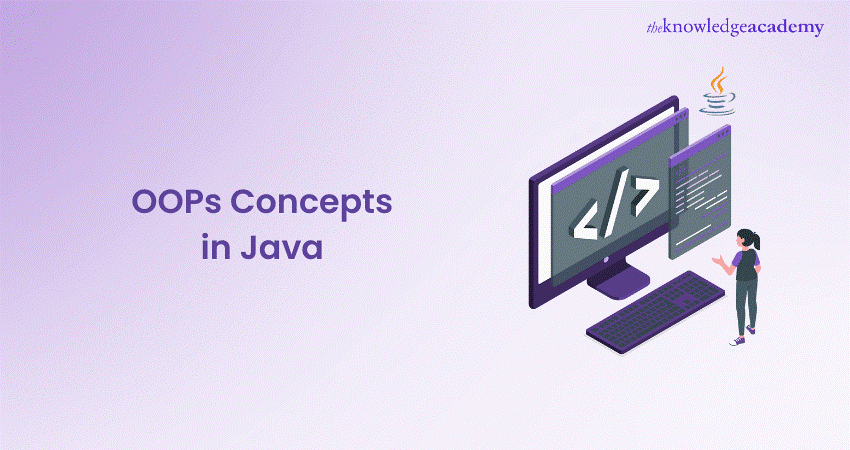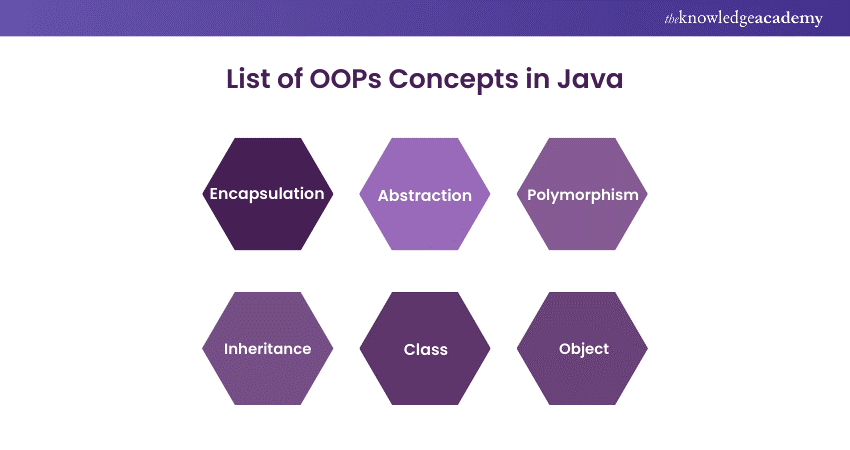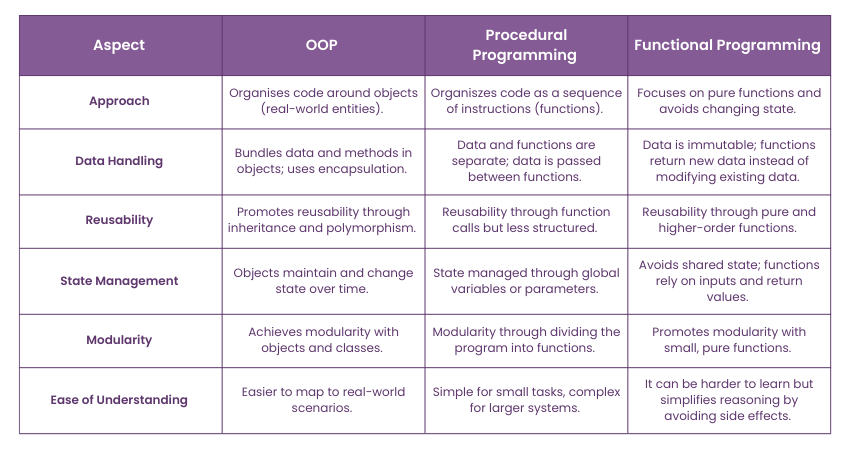We may not have the course you’re looking for. If you enquire or give us a call on +44 1344 203 999 and speak to our training experts, we may still be able to help with your training requirements.
Training Outcomes Within Your Budget!
We ensure quality, budget-alignment, and timely delivery by our expert instructors.

Have you ever wondered how a simple Java class can mimic real-world entities so effectively? This is where OOPs Concepts in Java come into play, allowing programmers to encapsulate data, inherit properties, and create flexible and reusable code structures. Whether you’re designing a simple application or architecting a complex system, these concepts enable you to craft scalable and maintainable software.
This blog explores Object Oriented Programming (OOPs) Concepts in Java and its importance in building scalable, maintainable, and flexible software. From understanding the basics of encapsulation, inheritance, and polymorphism to contrasting OOP with other programming styles, we’ll cover it all. So, get ready to unlock the full potential of OOPs Concepts in Java and take your coding skills to the next level!
Table of Contents
1) What is Object Oriented Programming (OOPs)?
2) What are OOPs in Java?
3) List of OOPs Concepts in Java
4) The Working of OOP Concepts in Java
5) Terms Used in Object Oriented Design
6) Differences Between OOP and Other Programming Styles
7) Advantages of OOPs Concepts
8) Conclusion
What is Object Oriented Programming System (OOPs)?
Object Oriented Programming (OOP) is a paradigm that centres on "objects," which encapsulate data (attributes) and code (methods) to model real-world entities and their interactions. OOPs enable the creation of classes that define the blueprint of objects, promoting modularity and reusability.
The four fundamental principles of OOPs are encapsulation, abstraction, inheritance, and polymorphism. These principles make OOPs a powerful approach for building complex, scalable software systems.
What are OOPs in Java?
OOPs in Java refers to the Object Oriented Programming principles that Java is built upon, enabling developers to create modular, reusable, and maintainable code.
Java Follows the Core OOP Principles:
a) Encapsulation: Grouping related data and methods into classes
b) Inheritance: Deriving new classes from existing ones to reuse code
c) Polymorphism: Allowing methods to perform differently based on the object calling them
d) Abstraction: Hiding implementation details and exposing only the necessary functionality
These principles allow Java programs to be organised into objects, making the software easier to manage, scale, and extend, particularly in complex applications.
Learn how to develop web applications using Java programming with our Web Development Using Java Training now!
List of OOPs Concepts in Java
Following is the list of Java OOPs concepts:
1) Encapsulation: Bundling data (attributes) and methods that operate on the data within a class, restricting direct access to some components.
2) Inheritance: Mechanism for creating a new class (subclass) from an existing class (superclass), inheriting its attributes and methods.
3) Polymorphism: Ability for a method to perform different tasks based on the object calling it, typically achieved through method overloading and overriding.
4) Abstraction: Hiding the complex implementation details and exposing only the necessary functionalities to the user.
5) Class: A blueprint for creating objects, outlining their attributes and behaviours.
6) Object: An instance of a class that represents a real-world entity with its state (attributes) and behaviour (methods).

The Working of OOP Concepts in Java
Java's OOPs concept allows programmers to design reusable components that ensure security across various use cases. Read further to understand the workings in more detail:
How Does Abstraction Work?
Abstraction in Java simplifies complex systems by hiding implementation details and exposing only essential features. It enables the creation of abstract classes and interfaces that define methods without specifying their exact behaviour. Concrete classes then implement these methods.
Here's How Abstraction Works:
1) Abstract Class/Interface: Defines a blueprint with abstract methods that must be implemented by subclasses.
2) Concrete Class: Provides specific implementations for the abstract methods.
Example:
a) The ‘Circle’ class offers a specific implementation of the ‘draw()’ method defined in the abstract ‘Shape’ class.
b) The ‘main’ method demonstrates creating a ‘Circle’ object and invoking the ‘draw()’ method, which abstracts the specific drawing details.
|
// Abstract class defining the blueprint for shapes abstract class Shape { abstract void draw(); // Abstract method to be implemented by subclasses } // Concrete class extending the abstract class class Circle extends Shape { @Override void draw() { System.out.println("Drawing a circle"); } } // Main class to test the abstraction public class Main { public static void main(String[] args) { Shape myShape = new Circle(); // Using the abstract type Shape myShape.draw(); // Calls the overridden method in Circle } } |
Output:
|
Drawing a circle |
How Does Encapsulation Work?
Encapsulation in Java combines data (attributes) and methods (functions) into a single class while controlling access to certain parts of the object's components. It ensures controlled access to data through getters and setters.
Here's How Encapsulation Works:
1) Private Attributes: Data is hidden from outside access
2) Public Methods: Getters and setters provide controlled access to the private data
Example:
a) The ‘Person’ class uses private fields and public methods to control access and modification.
b) The ‘main’ method shows how to interact with the ‘Person’ object using encapsulated methods.
|
public class Person { // Private fields private String name; private int age; // Public constructor public Person(String name, int age) { this.name = name; this.age = age; } // Public getter for name public String getName() { return name; } // Public setter for name public void setName(String name) { this.name = name; } // Public getter for age public int getAge() { return age; } // Public setter for age public void setAge(int age) { if (age > 0) { // Validating the age this.age = age; } else { System.out.println("Age must be positive."); } } // Main method to test the Person class public static void main(String[] args) { // Creating a Person object Person person = new Person("Alice", 30); // Accessing and modifying data through getters and setters System.out.println("Name: " + person.getName()); System.out.println("Age: " + person.getAge()); // Setting new values person.setName("Bob"); person.setAge(25); // Trying to set an invalid age person.setAge(-5); // This will trigger validation message
// Display updated values System.out.println("Updated Name: " + person.getName()); System.out.println("Updated Age: " + person.getAge()); } } |
Output:
|
Name: Alice Age: 30 Age must be positive. Updated Name: Bob Updated Age: 25 |
How Does Inheritance Work?
Inheritance in Java allows a new class to acquire properties and methods from an existing class. This encourages code reuse and defines a class hierarchy. The original class is known as the superclass or parent class, while the new class is referred to as the subclass or child class.
Here's How Inheritance Works:
1) Superclass: Defines common attributes and methods that can be inherited by subclasses.
2) Subclass: Extends the superclass using the extends keyword, inheriting its attributes and methods. It can also override methods or add new ones.
Example:
a) Inheritance: The ‘Dog’ class inherits from ‘Animal’, allowing it to use the ‘eat()’ method.
b) Method Addition: ‘Dog’ adds its own ‘bark()’ method.
c) Object Interaction: In the ‘Main’ class, a ‘Dog’ object uses both inherited and its specific methods, showcasing polymorphism and class hierarchy utilisation.
|
// Superclass class Animal { void eat() { System.out.println("This animal eats food."); } } // Subclass class Dog extends Animal { void bark() { System.out.println("The dog barks."); } } // Main class public class Main { public static void main(String[] args) { Dog myDog = new Dog(); myDog.eat(); // Inherited method myDog.bark(); // Subclass method } } |
Output:
|
This animal eats food. The dog barks. |
How Does Polymorphism Work?
Polymorphism in Java allows objects to be treated as instances of their parent class rather than their actual class. It enables method overriding and method overloading, enabling methods to perform various tasks based on the object or parameters.
Here's How Polymorphism Works:
1) Method Overriding: Subclasses provide a specific implementation of a method defined in the superclass.
2) Method Overloading: A class can have multiple methods with the same name but different parameters.
Example:
a) Inheritance: The ‘Dog’ class is a type of ‘Animal’, so it inherits all behaviours (methods) from the ‘Animal’ class.
b) Method Overriding: The ‘Dog’ class changes (overrides) the’ makeSound()’ method to print "Dog barks." instead of the generic animal sound.
c) Polymorphism: When we call ‘makeSound()’ on an ‘Animal’ reference holding a ‘Dog’ object, it uses the ‘Dog’'s version of the method, showing how the same method call can have different behaviours based on the object type.
|
// Superclass class Animal { void makeSound() { System.out.println("Animal makes a sound."); } } // Subclass class Dog extends Animal { @Override void makeSound() { System.out.println("Dog barks."); } } // Main class class Main { public static void main(String[] args) { Animal myAnimal = new Dog(); // Using an Animal reference to hold a Dog object myAnimal.makeSound(); // Polymorphism: Calls the Dog's override of makeSound } } |
Output:
|
Dog barks. |
Explore our complete Java Courses and gain the skills needed for success – sign up for our training today!
Terms Used in Object Oriented Design
The following are key Object Oriented design concepts:
1) Coupling:
Coupling measures how much one class relies on another, indicating the level of direct interaction between them. This means how often changes in one class might affect another class. In good design practices, low coupling is preferred as it reduces the impact of changes and eases maintenance.
2) Cohesion:
Cohesion measures how closely the responsibilities within a class or module align with each other. High cohesion within a class means that its tasks are closely related to each other, improving readability and maintainability because changes to tightly related features are all handled within a single class.
3) Association:
The association represents the relationship between two classes where one class object is associated with another class object. It represents the concept of "has-a" and "uses-a" relationships. Associations can be one-to-one, one-to-many, or many-to-many.
4) Aggregation:
Aggregation is a customised form of association where one class is a container or collection of other classes but does not strictly own them. It's often referred to as a "whole-part" relationship, where components can exist independently of the whole. For example, a library may contain many books, but the books will not be destroyed if the library ceases to exist.
5) Composition:
Composition is also a form of association but with a stronger relationship. In composition, one class owns another class, meaning if the owner class is destroyed, the owned class will also be destroyed. This represents a strong "part-whole" or "contains-a" relationship. For example, a House contains Rooms, and rooms cannot exist without the house.
Differences Between OOPs and Other Programming Styles
Here's a simple table summarising the differences between Object Oriented Programming and other programming styles (Procedural and Functional):

Dive into JavaScript and build interactive websites, start your journey now with our JavaScript for Beginners Course – sign up today!
Advantages of OOPs Concepts
Here are some advantages of Object Oriented Programming concepts in Java:
1) Modularity: Code is organised into separate, reusable objects, making it easier to manage and modify.
2) Reusability: Inheritance allows the reuse of existing code, reducing redundancy and improving efficiency.
3) Scalability: OOP allows systems to grow more easily by adding new objects without affecting existing code.
4) Maintainability: Encapsulation hides internal object details, making the code easier to maintain and modify.
5) Flexibility: Polymorphism allows objects to be treated as instances of their parent class, enabling flexibility and dynamic behaviour.
6) Real-world Modeling: OOP closely mirrors real-world entities and relationships, making it intuitive to design and understand.
7) Security: Encapsulation restricts direct access to data, protecting it from unintended interference and misuse.
Join our Java Programming Course today – Learn to code, develop innovative solutions, and take your career to the next level!
Conclusion
Understanding and applying OOPs Concepts in Java is crucial for developing flexible, scalable, and maintainable software. By mastering these principles, you'll enhance your ability to build robust applications and fully leverage Java’s capabilities. Embrace these concepts to elevate your programming skills and create innovative solutions.
Know how to develop an application using Java with our Java Swing Development Training course today!
Frequently Asked Questions

The four basics of OOPs are:
1) Encapsulation: Bundling data and methods into a class
2) Inheritance: Creating new classes from existing ones
3) Polymorphism: Methods behaving differently based on the object
4) Abstraction: Hiding complex implementation details

OOP enhances code maintenance and reusability in Java by organising code into distinct classes and objects. This modular design facilitates eas`ier updates and debugging. Additionally, inheritance and polymorphism allow for efficient code reuse, further streamlining maintenance tasks.

The Knowledge Academy takes global learning to new heights, offering over 30,000 online courses across 490+ locations in 220 countries. This expansive reach ensures accessibility and convenience for learners worldwide.
Alongside our diverse Online Course Catalogue, encompassing 17 major categories, we go the extra mile by providing a plethora of free educational Online Resources like News updates, Blogs, videos, webinars, and interview questions. Tailoring learning experiences further, professionals can maximise value with customisable Course Bundles of TKA.
The Knowledge Academy’s Knowledge Pass, a prepaid voucher, adds another layer of flexibility, allowing course bookings over a 12-month period. Join us on a journey where education knows no bounds.

The Knowledge Academy’s Knowledge Pass, a prepaid voucher, adds another layer of flexibility, allowing course bookings over a 12-month period. Join us on a journey where education knows no bounds.

The Knowledge Academy offers various Java Courses, including Java Programming, JavaScript for Beginners, Web Development Using Java Training and Java Engineer Training. These courses cater to different skill levels, providing comprehensive insights into Java Developer Job Description.
Our Programming & DevOps Blogs cover a range of topics related to Java, offering valuable resources, best practices, and industry insights. Whether you are a beginner or looking to advance your Programming skills, The Knowledge Academy's diverse courses and informative blogs have got you covered.
Upcoming Programming & DevOps Resources Batches & Dates
Date
 Java Programming
Java Programming
Mon 20th Jan 2025
Mon 3rd Mar 2025
Mon 12th May 2025
Mon 14th Jul 2025
Mon 22nd Sep 2025
Mon 17th Nov 2025







 Top Rated Course
Top Rated Course



 If you wish to make any changes to your course, please
If you wish to make any changes to your course, please


